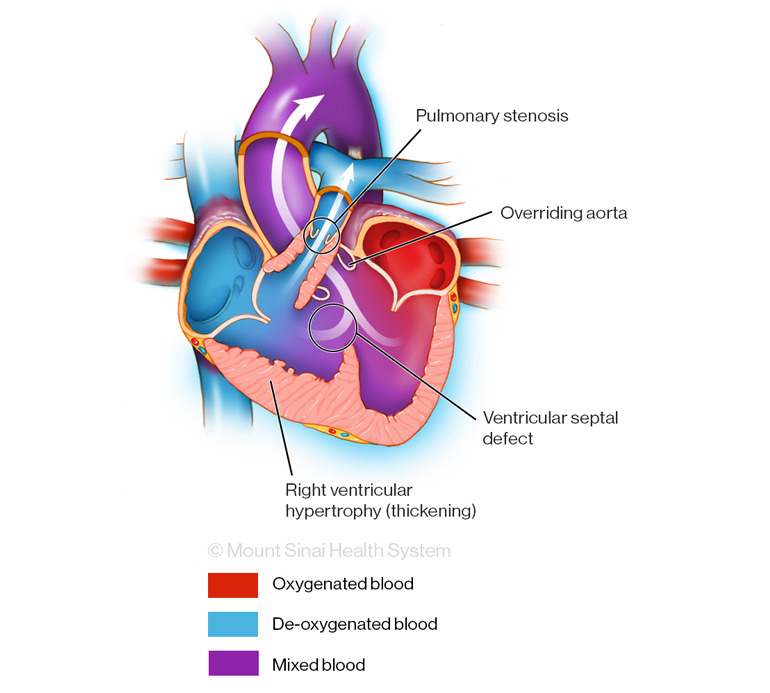
Tetralogy of Fallot
Tetralogy of Fallot is the result of structural defects in the heart, which affect how your baby’s blood flows. Normally, oxygen-poor blood goes to the lungs, where it gains oxygen. Then, this oxygen-rich body goes throughout the body, providing needed nutrients. However, with tetralogy of Fallot your baby’s blood is poorly oxygenated.
The structural defects that are part of the condition include:
- Ventricular septal defect—is a hole between the lower pumping chambers of the heart
- Overriding aorta—positions the large artery on top of the right and left ventricles instead of on the left, where it should pump oxygenated blood to the body
- Pulmonary valve and artery issues—causes a narrowing of the pulmonary valve (pulmonary stenosis) along with a thickening of the muscle below, restricting proper blood flow. Also, the pulmonary arteries, the blood vessels that supply the lungs with blood, may be small or abnormally formed.
- Right ventricular hypertrophy—results from the right ventricle being too muscular and working harder to pump blood.

Symptoms
When oxygen levels in your baby are severely low, it gives your baby dusky, blue skin. But with mild restriction of blood flow to the lungs, your child’s symptom may be a heart murmur that your pediatrician can detect by listening.
Diagnosis
If we are able to diagnose tetralogy of Fallot in utero, using a fetal echocardiogram or ultrasound, we will refer you to our Fetal Heart Program so our specialists can manage your delivery and take care of your newborn.
Diagnosis after birth may require the following tests:
- Pulse oximetry—a painless way to monitor the oxygen content of the blood
- Electrocardiogram (ECG or EKG)—records electrical signals as they travel through your child’s heart allowing us to see if there are abnormal heart patterns
- Echocardiogram—uses sound waves to create real-time images of the heart that show abnormal blood flow through the heart, and any holes or abnormal heart valves
- Chest X-ray—shows if your child’s heart is enlarged
- Cardiac catheterization—uses dye to make the heart structures visible on X-rays. We inject the dye through a catheter (a thin flexible tube) so we can take pictures of the small blood vessels and measure pressure in your child’s heart chambers
Treatments We Offer
Most babies born with tetralogy of Fallot do not need immediate surgery or treatment. You should be able to take your baby home soon after birth. In most instances, your baby will need surgery to repair the defect during the first year of life, usually between four and six months of age.
When blood flow to the lungs is severely obstructed in newborns, we may need to perform a procedure to insert a surgical tube that brings more blood to the lungs. We place a stent during cardiac catheterization. Or we may perform a complete surgical repair of the defect.
There are several approaches to the surgery, which all include closing the ventricular septal defect with a patch. The approaches vary in the way each treats the obstruction of blood flow to the lungs. Your child’s surgeon will explain fully what your child needs and what each of the following approaches involves:
- Valve sparing repair—if the obstruction of the pulmonary valve is not too severe, we may be able to preserve the function of the valve while relieving the obstruction between the right ventricle and the pulmonary arteries with a muscle bundle resection and patching.
- Transannular patch—when the pulmonary valve is too small to preserve, we may cut across it and place a patch over the right ventricular outflow tract.
- Conduit—if your child is born without a pulmonary valve (pulmonary atresia), we can implant a conduit or tube to connect the right ventricle to the pulmonary arteries.
Sometimes, as children get older, a leaky heart valve and irregular heartbeat may occur. We are here to diagnose and treat your child as needed.
In all cases of tetralogy of Fallot, your child will need the care of a pediatric cardiologist into adulthood. Our Children’s Heart Center team can treat your child at all ages, even as an adult.
Why Choose Children’s Heart Center
Our pediatric cardiologists are experienced in diagnosing and treating tetralogy of Fallot. To ensure long-term health, your child will need lifelong follow-up care after surgery with one of our cardiologists trained in congenital heart disease.
All we do is to provide your child the best and most personalized and compassionate care.